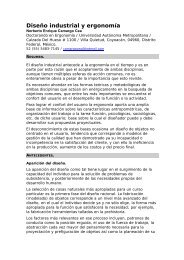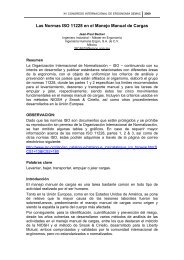ERGONOMÍA OCUPACIONAL - SOCIEDAD DE ERGONOMISTAS ...
ERGONOMÍA OCUPACIONAL - SOCIEDAD DE ERGONOMISTAS ...
ERGONOMÍA OCUPACIONAL - SOCIEDAD DE ERGONOMISTAS ...
You also want an ePaper? Increase the reach of your titles
YUMPU automatically turns print PDFs into web optimized ePapers that Google loves.
Ergonomía Ocupacional. Investigaciones y Aplicaciones. Vol 3 2010<br />
was 34.87°C, strength was 63 kg and cycles per minute was 140 movements and the minimum in:<br />
temperature was 29.38°C, strength was 32 kg and cycles per minute was 100 movements.<br />
Conclusion: On based on this study the conclusion was: correlation exists between temperature<br />
against cycles per minute and strength against cycles per minute; and there is no correlation<br />
between temperature and strength.<br />
Keywords: Temperature, Strength, Cycles per minute.<br />
1. INTRODUCTION<br />
The need to protect workers against the causes of occupational diseases and accidents is a<br />
question no doubt. All sources of work should carry out activities aimed at the prevention of<br />
occupational hazards, with consequent advantages in production and productivity, achieving<br />
greater social welfare, which is reflected in the economy of the company. The ergonomic<br />
approach is to design products and work to adapt them to the people and not vice versa. The logic<br />
that uses the ergonomics is based on the principle that people are more important than the<br />
objects or production processes; and therefore, cases where it arises any conflict of interest<br />
between people and things, should prevail people (Tortosa et al., 1999).<br />
Ergonomic hazards have been an issue to consider, for injuries caused to workers in work areas.<br />
For industry it is always important the health of the workers, because by avoiding the DTA's in it<br />
reduces their costs for disabilities, absenteeism and more importantly for investors.<br />
Musculoskeletal injuries are disorders characterized by an abnormal condition of muscle, tendons,<br />
nerves, vessels, joints, bones or ligaments, which results in impairment of motor or sensory<br />
function caused by exposure to risk factors: repetition, strength, inappropriate postures, contact<br />
stress and vibration (Sinclair, 2001). For example, some of the injuries and illnesses common in<br />
the wrist area causing repetitive or poorly designed work are:<br />
• Tenosynovitis: is an inflammation of the synovial capsule, this is the sheath that covers<br />
tendons. Tenosynovitis can occur in any tendon with a synovial sheath. However, most often<br />
Sociedad de Ergonomistas de México, A.C. 100




